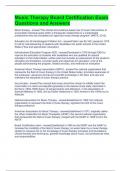Exam (elaborations)
Music Therapy Board Certification Exam Questions and Answers
- Course
- Institution
Music Therapy Board Certification Exam Questions and Answers Music therapy "The clinical and evidence-based use of music interventions to accomplish individual goals within a therapeutic relationship by a credentialed professional who has completed an approved music therapy program" (AMTA, 2015)....
[Show more]



